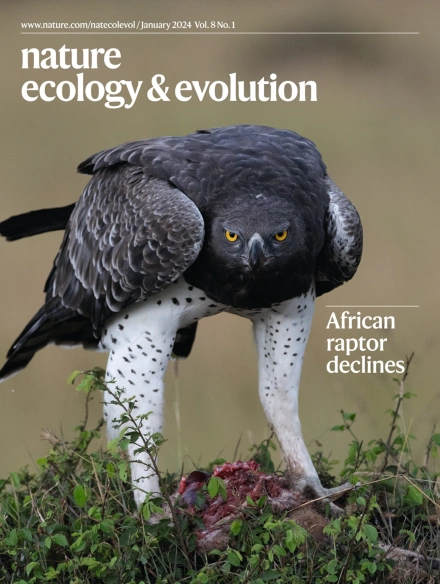Methane fuel for sea spiders
IF 13.9
1区 生物学
Q1 ECOLOGY
引用次数: 0
海蜘蛛的甲烷燃料
深海探测揭示了不依靠光合作用提供动力的生态系统的存在。例如,微生物能够代谢从甲烷渗漏中释放的碳氢化合物,形成了由数百种动物组成的食物网的基础。现在,发表在《美国国家科学院院刊》上的一项研究表明,一些海蜘蛛(来自海蛛纲)通过以生活在它们外骨骼上的化学自养细菌为食,利用甲烷渗漏的化学能。在加利福尼亚和阿拉斯加海岸的海洋探险中,Dal Bó和他的同事收集了三种只从甲烷渗漏中发现的海蜘蛛标本。通过测序分析和显微镜观察,他们在海蜘蛛体内发现了丰富多样的甲烷营养和甲基营养细菌。这种联系不仅仅是表面上的:同位素标记实验和随后的单细胞成像和消化组织分析表明,海蜘蛛通过消耗甲烷氧化细菌来吸收甲烷衍生的碳。成年雄性携带的卵囊上也存在这种细菌,这表明这些无脊椎动物将它们的微生物共生体传给了它们的后代。Dal Bó和同事们的发现,除了让海蜘蛛和胸毛雪人蟹一起成为已知在自己身上培育特殊细菌的动物之外,还表明,关于海洋深处的生命形式和生态系统,还有很多有待发现的地方。原始参考文献:《自然科学进展》。USA 122, e2501422122 (2025)
本文章由计算机程序翻译,如有差异,请以英文原文为准。
求助全文
约1分钟内获得全文
求助全文
来源期刊

Nature ecology & evolution
Agricultural and Biological Sciences-Ecology, Evolution, Behavior and Systematics
CiteScore
22.20
自引率
2.40%
发文量
282
期刊介绍:
Nature Ecology & Evolution is interested in the full spectrum of ecological and evolutionary biology, encompassing approaches at the molecular, organismal, population, community and ecosystem levels, as well as relevant parts of the social sciences. Nature Ecology & Evolution provides a place where all researchers and policymakers interested in all aspects of life's diversity can come together to learn about the most accomplished and significant advances in the field and to discuss topical issues. An online-only monthly journal, our broad scope ensures that the research published reaches the widest possible audience of scientists.
 求助内容:
求助内容: 应助结果提醒方式:
应助结果提醒方式:


